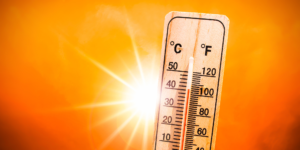
June 2023 became a month with record heat waves in the US because while some states have suffered extreme heat waves, others have been hit by severe weather, such is the case of extreme floods, droughts and bad weather. air quality.
According to experts from National Centers for Environmental Information of the National Oceanic and Atmospheric Administration ?NOAASo far this year, there have been 12 separate weather and climate disasters that have cost the nation billions of dollars, including outbreaks of tornadoes, extreme flooding, and a winter storm.
Thus, in this sixth month of 2023, the average temperature in the United States was 69.0 degrees F ?0.5 degrees above average?, ranking in the middle third of the 129-year climate record.
Temperatures were above average from the Pacific Northwest to the northern plains, as well as the southern plains and the Florida panhandle. North Dakota saw its third warmest June on record, while Louisiana and Minnesota each had a June 10th warmest on record.
Meanwhile, West Virginia and Virginia had their ninth and 10th coldest Junes on record, respectively.
In the case of precipitation, it was .85 inches, 0.08 inches below the average, placing it in the middle third of the historical record.
Wisconsin and Michigan each had their fifth driest June on record, while Illinois and Missouri had a June in the top 10 driest. Wyoming saw its third wettest June on record with Colorado and Maine having one of their 10 wettest Junes.
From January to June 2023
The situation has not been the best during the first 6 months of the year throughout the country, as the average temperature was 49.2 degrees F ?1.7 degrees above the 20th century average?, ranking as the 21st warmest year on record.
Florida's January-June period ranked as the warmest on record, while Massachusetts had the second-warmest.
Another 27 states were in the top 10 warmest of its kind, while no state saw its top 10 coldest for January through June.
The precipitation total was 15.70 inches, 0.39 of an inch above average, which was in the middle third of the record.
Rainfall was above average from California to the Rocky Mountains and in parts of the southern Mississippi Valley, northern Great Lakes, Southeast, and Northeast. In contrast, they were below average in parts of the Northwest, the Northern and Central Plains, the Southwest, the central Mississippi Valley, the Mid-Atlantic, and along parts of the Gulf Coast.
Over those six months, there were 12 individual billion-dollar weather and climate disasters that included one winter storm, one flood, and 10 severe weather events.
These events caused 100 direct and indirect deaths and produced more than 32.7 billion dollars in damages. This puts the number of events and price this year in second place, behind the first six months of 2017 ?14 disasters? and 2021 ?42.500 million dollars?, respectively.
Since 1980, when NOAA began tracking these events in the US, the nation has experienced 360 separate weather and climate disasters where overall damage/costs reached or exceeded $1 billion per event. The total cost of all of them exceeded 2.57 trillion.
You may be interested in: They call to prevent against the extreme temperatures expected for this summer


